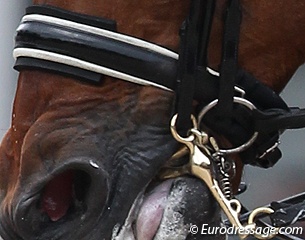
Training and competition issues relating to the noseband have been flaring up in the media in the wake of the discussions involving the proposed blood rule. Eurodressage will be featuring a "Noseband Special' this week with in-depth articles on the history and use of the noseband as well as interviews with trainers about their personal noseband preference. We start the "Noseband Special" with an important statement by the International Society of Equitation Science (ISES) on restrictive nosebands.
ISES issued a statement on their position and recommendations concerning restrictive nosebands:
Background
Extreme tightening of the noseband may force the mucous membranes lining the cheek against the molar teeth and is thought to increase the bitted horse’s compliance and responsiveness to rein pressure, perhaps by sensitising its mouth (Randle & McGreevy, 2011). This may advantage the rider since the horse appears to achieve a lighter rein contact, colloquially referred to as becoming more ‘submissive’. However, tightening the noseband is likely to mask the horse’s natural comfort-seeking responses by restricting jaw and tongue movements that disclose resistance and behavioural conflict.
Recent evidence suggests that horses wearing tight nosebands undergo a physiological stress response, are sensitised to bit pressure and may have reduced blood flow (McGreevy et al., 2012). Consequently, on welfare grounds, the use of nosebands that constrict with potential to cause injuries should not be permitted in training or competition.
 Tight nosebands can mask unwanted behaviour in horses, which might be indicative of either pain or deficiencies in training, or, indeed, both. Consequently, the loosening of nosebands might reveal undesirable responses that could be dangerous to riders and other horse-rider combinations. Riders should therefore rule out any pain-related issues in their horses and ensure that their horses are trained according to principles of learning theory to meet the demands of competition.
Tight nosebands can mask unwanted behaviour in horses, which might be indicative of either pain or deficiencies in training, or, indeed, both. Consequently, the loosening of nosebands might reveal undesirable responses that could be dangerous to riders and other horse-rider combinations. Riders should therefore rule out any pain-related issues in their horses and ensure that their horses are trained according to principles of learning theory to meet the demands of competition.
In most equestrian disciplines, gear stewards check that all equipment used on horses competing complies with the specified regulations. By implementing a process that can be used to remove or loosen tight nosebands, stewards could ensure that the detrimental effects of these devices could be eliminated or at least lessened.
Furthermore, it is an established principle of ethical equitation that the horse’s relaxation must be benchmarked (McGreevy & McLean, 2007; ISES, 2011). This entails training lightness of rein contact by carefully eliminating expressions of mouth discomfort such as opening, gaping or crossing the jaw. Indeed, in the same vein, some equestrian manuals and competition rule books propose that ‘two fingers’ be used as a spacer to guard against over-tightening, but fail to specify where this gauge should be applied or, indeed, the size of the fingers. The dimensions of average adult first and index fingers at the second joint are: 1.59 × 3.87 × 9.89 cm (McGreevy et al., 2012). This amount of space under the noseband allows horses to express conflict behaviour and so aligns with the principles of ethical equitation. That said, it does not permit horses to perform the full repertoire of behaviours, including yawning (McGreevy et al., 2012).
 Recommendation
Recommendation
ISES recommends that all equestrian sports should require that the tightness of any noseband is checked by a steward at the nasal midline (see Fig.1).
For fairness and objectivity, a taper gauge inserted under the noseband should be used for this purpose. The gauge should be placed without force and be clearly marked to show the desired stop which, in alignment with established industry guidance, should be the dimensions of two average adult fingers.
Riders should be advised and encouraged to use the same gauge in practice.
Read The Next Article in our Noseband Special: Part I: The History of the Noseband
Related Links
Editorial: A Slip of the Tongue
A Coming Together of Minds at the 2011 FEI Young Horse Seminar and Judges Course
Making Progress at the 2010 Global Dressage Forum